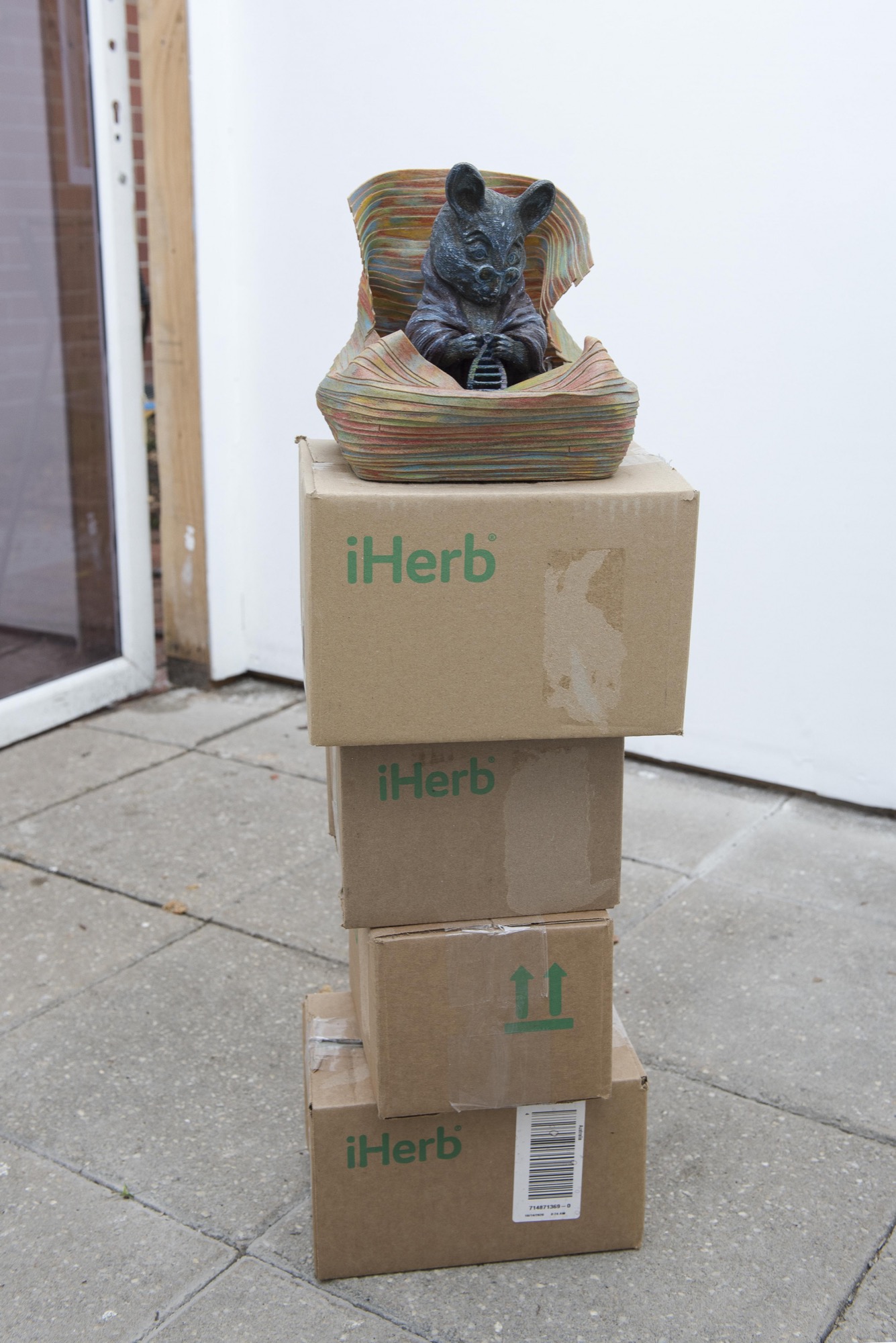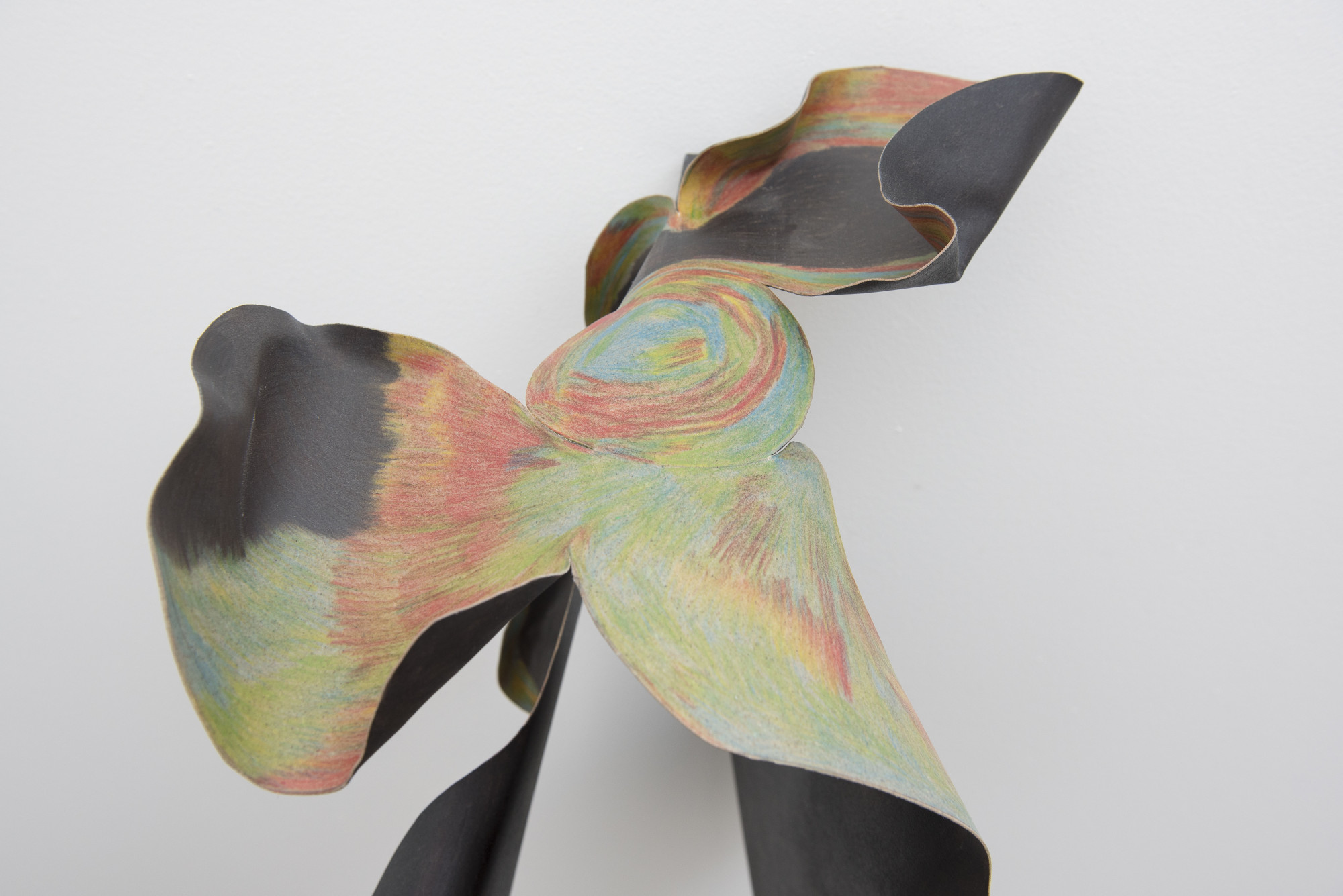Chris Madden: Fact Republic
Cameron Hurst
April was laden with bespoke events that combined fine food and fine art, prosecco pouring as tragic catalogue essays languished amongst the bacchanalia. Dégustation at Discordia featured vodka cured snapper tartare and roasted potato gelato with wattleseed choux: divine. Xmas at Guzzler showed two steel poles filled with rotten festive remains: disgusting. Gloppy grazing for the pastel ceramics set was covered by Please Do Not Eat The Sculptures at Missing Persons. Chris Madden’s exhibition Fact Republic at Savage Garden, the subject of this review, falls somewhere in the middle of this spectrum. I came for the mimosas, bagels (Mile End), and batch brew (Everyday Coffee). I stayed for the mayonnaise (Praise).
Madden’s show is made up of six sculptures and a sprawling text. It’s exhibited in a freshly built backyard gallery in a Carlton North sharehouse, another one where residents can maintain immaculate white plaster walls in the gallery room but can’t seem to find time to wash dirty dishes in the next. Madden, who suffers from a chronic illness, described the works as “a bunch of sculptures I made during the last six to nine months, in a period where I was particularly unwell. That being said, my being unwell was not really the reason these works were made.” Illness is a backdrop to the show, but the works expand to cover disparate themes: primal shames and subliminal linkages of various intakes (foodstuffs, medications, parenting, images, religion, vitamins, class consciousness, bacteria, art) and their inevitable regurgitations from the body in altered forms. It’s holistic.
In her 1978 essay Illness as Metaphor, Susan Sontag writes that mythologising sickness shrouds practical responses to managing serious physical pain. In order to be liberated from the obfuscating unrealities of illness metaphors, however, you first have to articulate them. To this end, the essay begins with a metaphor:
Illness is the night-side of life, a more onerous citizenship. Everyone who is born holds dual citizenship, in the kingdom of the well and in the kingdom of the sick. Although we all prefer to use only the good passport, sooner or later each of us is obliged, at least for a spell, to identify ourselves as citizens of that other place.

The word “kingdom” weirdly fits the sensibility of Madden’s Fact Republic. It invokes a D&D-esque fantasy world, one in which the primary material is a versatile thermoplastic favoured by cosplay artists. Fact Republic is Madden’s kingdom, of the well and of the sick.
The gallery, Savage Garden, is a compact cubicle, 2.8 by 3 metres, built from materials recycled from MUMA. The high ceiling, made from translucent sanded perspex, is probably the best bit. Natural light filters through the space in lieu of orthodox fluorescents; it’s beatific and sustainable. At the opening, my first visit to the gallery, the space was sunlit and busy. Attendees awkwardly sidled around one another to enter. Charismatic bleach-haired painters handed round drinks. It was hard to look closely at the work without bumping into someone. A few weeks later, I went back alone on a wintery May day to look again, properly. A soft grey rain spattered the perspex, the artworks cast in a cool, dim light.
The first sculpture I re-encountered was a small figurine facing away from the doorway, propped on a plinth comprised of four iHerb boxes. iHerb is a Californian nutritional product distribution company, essentially the Amazon of wellness culture, whose presence features heavily in Fact Republic. Monument to the Monument of the Laboratory Mouse is a miniature replica of a large, bronze sculpture of a rodent knitting DNA strands. The original sits 11,000 kilometres away outside the Institute of Cytology and Genetics of the Russian Academy of Sciences in Siberia. Madden’s local iteration is 3D-printed and snuggled in a nest made from Worbla (the cosplay thermoplastic). The little rat wears round spectacles and an expression of martyred wisdom. The industrial scale of lab-based animal abuse (which has, in pragmatic terms, produced incredible results for biomedicine) is transfigured into a twee anthropomorph and stacked, teetering, on a tower of iHerb boxes. What to make of these cardboard containers? I read them as ambiguous symbols of corporate wellness culture. Dubious and discounted on the one hand, built on verdant pyramid schemes, but on the other hand, Western medicine isn’t the be-all and end-all. There is a certain ambivalence to the boxes’ prominence in the show. Maybe Madden is reaching for an uneasy balance between two conflicting epistemes. The quantity of the boxes made me wonder what they had once contained.
On the far side of the gallery, an amorphous piece made from curls of rainbow-pencil covered Worbla tumbles down the wall. Another thermoplastic fauna, this one with blue, reptilian skin, unfurls from the ground. It feels like traversing a mythic biome. A couple of crescent Worbla panels are stuck up above the doorway. These two small pieces are unassuming and seem disconnected from the rest of the show. I hadn’t noticed them during my first foray to the gallery, and I’d question whether other visitors did. Their quiet presence is superseded by a work on the other wall of the space. A nobbly object sits propped atop two more iHerb boxes. Madden told me that this sculpture was made from a bootleg Worbla recipe the artist found on YouTube (Worbla is pretty expensive). They started with the recipe’s PCL pellets and then “went rogue” with lavender, dirt, woodchips, and eucalyptus. It’s like the singular waxy entity combines biomedicine and herbal treatments. When I peered at it closely, I could see fingerprints where the artist had gently pressed the lumpen mixture into shape. A conch-like amoeba, it seemed like a milky talisman fit to guide me through the darkest depths of an iHerb distribution centre.

The text accompanying the show is great; my only complaint is that it ends quite abruptly. The prose has a spiralling impetus reminiscent of the best David Foster Wallace short stories. Bravely starting in second-person narration, they ruminate on connections between the cultural narratives of art and chronic illness, make extended diversions into food scenes starring mum and dad, then loop back to sculpture and semiotics. Discussion of the Praise Salad Dressing Industrial Complex brought a lump to my throat. I almost cried when my younger brother sent me a video of his first sharehouse nachos, though. What is so particular, painful, vulnerable about food that is overshooting its status? In the acknowledgments of Brief Interviews with Hideous Men, Foster Wallace thanks both the Macarthur “Genius” Grant Foundation and “The Staff and Management of Denny’s 24 Hour Family Restaurant, Bloomington, IL.” There is something about this sanguine, slightly self-conscious equanimity that resonates with Fact Republic. Madden faces the seemingly polar positions of clinical biomedicine and alternative wellness culture with a similarly even-handed empathy.
In Illness as Metaphor, Sontag surveys TB as a disease of seventeenth– and eighteenth-century Romanticism, riddling the Age of Enlightenment. She brings up the “somnolent belles” of pre-Raphaelite paintings as tubercular icons, luxuriating in pallor. In the trailer for Goop Lab, Gwyneth Paltrow’s Netflix special on wellness culture that covers mind, body, and spirit, a glowing clinician declares that “the 21st century is the Age of Energy!” Times have changed. Madden performs a metaphorical transplant. Their sculptures visualise the new mythologies of the Age of Energy; instead of ill-health being a badge of glamorous languor, sickness has become a symptom of individualised spiritual rot and responsibility.
The sixth artwork in Fact Republic is a large, timber frame housing a mass of lumpy objects wrapped in grey thread. A fairytale toadstool is nestled in one section. The wooden support is papered with printouts of idyllic green landscapes populated by shadowy figures. Madden made the images by feeding pictures from their archive into a program that regenerates an initial image in the style of a second. It’s pure wiggery. Imagine that the red-haired beauty from John Everett Millais’ Ophelia was removed from her pond, replaced by a vaguely threatening giant amphibian, and the whole scene put through a hallucinogenic neural network like Google’s DeepDream. That might produce something like Fact Republic. The blossom-filled meadows in which Goop employees take magic mushrooms are refigured as nebulous underworlds. The word “wellness” barely even dented the popular lexicon until about 1980, when it exploded like over-fermented kombucha. Wellness is freaky: an active, striving, onerous state that demands more than just the neutrality of good health. It slaps of a healthcare based on rapacious consumption in a world of digitised context-collapse. Like everything else under the neoliberal agenda, good health is just another industry to be privatised, atomised and even more poorly subsidised.
Fact Republic fits into a trajectory of post-net net artists who make work imbued with but not necessarily made of the digital. Not horrendous meme art, in other words. There’s a folky, non-traditional materiality to a lot of the genre (hats off to the recent hoax Semiotext(e) publication titled Net Povera). It is hard to imagine the real and the bootleg Worbla material existing without the infrastructural web of YouTube tutorials, Deviantart communities, and cosplay message boards humming beneath its production. And the iHerb boxes function as a visual synecdoche for a whole set of networked associations, linking global supply chains with local bowel movements. The addition of the ‘i’ prefix is the most semantically concise, albeit tacky, transformation of an entity from neutral status to tech infused. Fact Republic is a small-scale iteration of post-net poster boy work–think Ed Atkins’ CGI LARP Ye Olde Foode (2019) or Simon Denny’s gamified extraction-core Mine (2020). I’m reminded of the New Models host Caroline Busta’s use of the term “dark forest” to describe the submerged terrains of inchoate web 3.0. All of these artists wander in different ways through dark forest spaces, representing them as filled with omnipresent, ambivalent forces with varying degrees of transparency.
Fact Republic is a good opener for Savage Garden. The sculptures are disparate but unanimously sweet. Looking again at the clumps of lavender set tenderly in with PCL pellets and dirt and at the shifting colours of the rainbow pencil on plastic, I felt a strange, intimate camaraderie with the amorphous entities. Madden has shared a generous kingdom of a show. It’s open for one more day. Gather your Worbla sword and your vitamins and don’t miss it.
Cameron Hurst is a writer based in Narrm/Melbourne.


